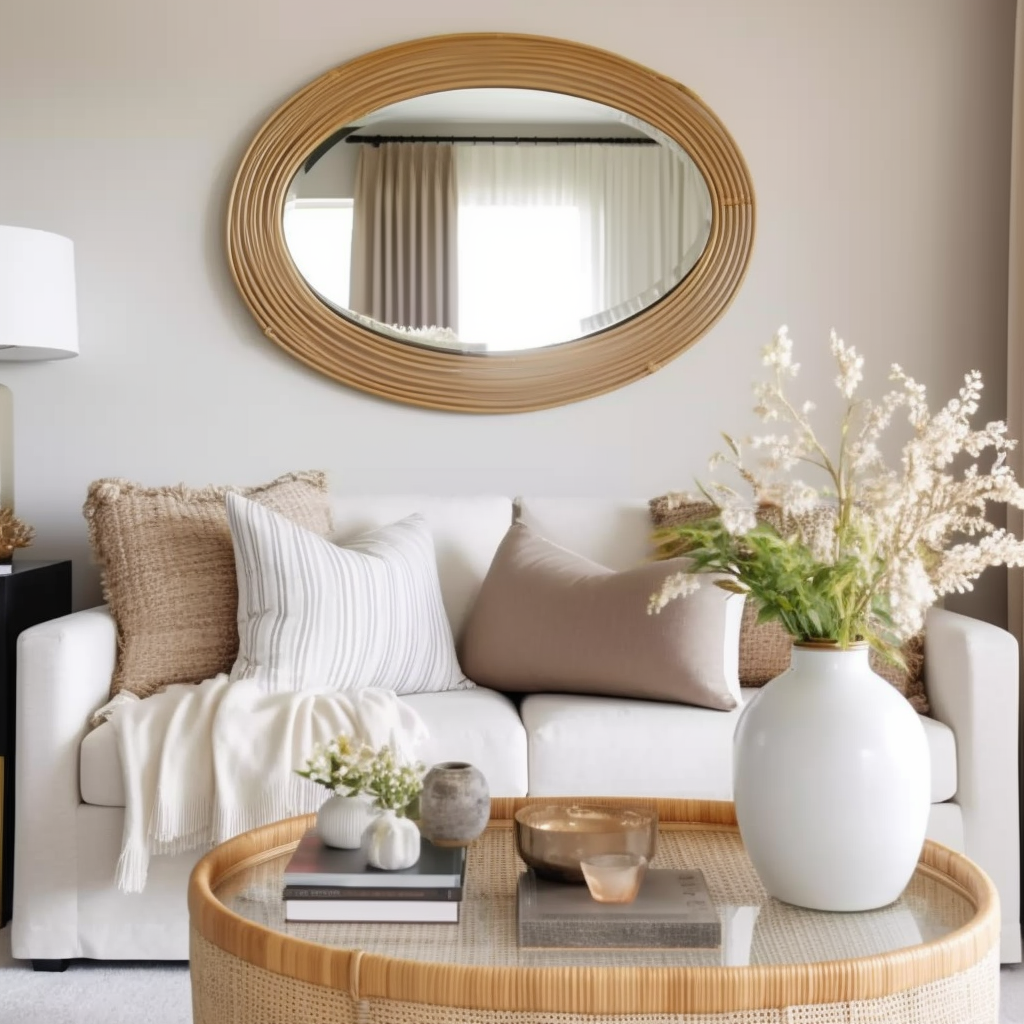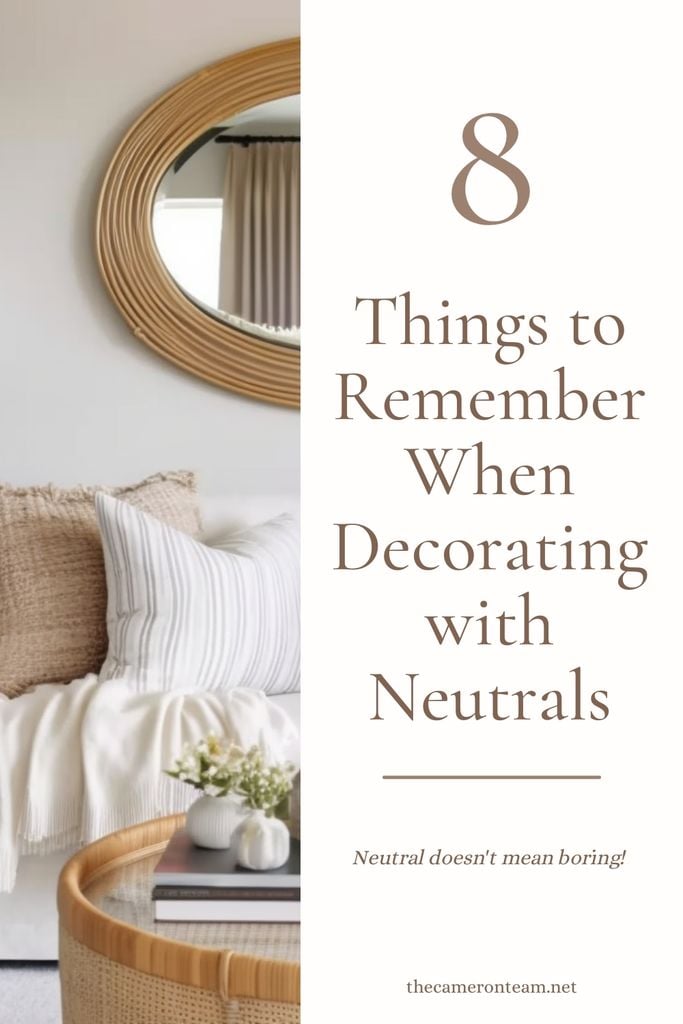Neutral colors are the cornerstone of timeless, elegant design. These colors, which include shades like black, white, brown, and gray, as well as intermediary hues like cream, taupe, tan, greige, beige, and clay, are the backdrop to many color trends. They are muted shades that subtly change their appearance in different lighting situations, revealing underlying colors that can add depth and complexity to a room.
There are warm neutrals, which include undertones of yellow, pink, and orange, and cool neutrals, which have undertones of blue, green, and purple. These undertones can subtly influence the mood and atmosphere of a room. When bold colors become overwhelming in a room, neutrals are usually the colors that provide balance, creating a calming and harmonious environment.
Here are 8 things to remember when decorating with a neutral color palette.
Please note: The Cameron Team has not been paid or received any other compensation to include any of the products featured on this post, but the author has included affiliate links and content. If you click on a link, they may earn a commission – a high-five for great content!
Warm Neutrals are On-Trend
In recent years, warm neutrals have seen a surge in popularity. Gray and greige, a blend of gray and beige, were particularly popular before and during the pandemic. However, in the past year or two, warm neutrals with yellow, orange, or pink undertones have become increasingly sought after. These colors have the ability to warm up a room, making it feel cozy, inviting, and comforting – a quality that many people have been craving in their homes recently.
Light-Colored Neutrals Make a Room Feel Larger
Light-colored neutrals have a magical ability to make a room feel larger and more spacious. This is why home sellers are often advised to choose neutral colors when repainting their interiors before a sale. It creates a blank canvas that allows potential buyers to envision their own belongings in the space. However, adding curtains can sometimes have the opposite effect, making a room feel smaller. To maintain the illusion of space, it’s a good idea to match the curtains’ hue to the neutral wall color.
Consider the Lighting When Choosing Neutrals
The appearance of neutral colors can change dramatically depending on the lighting. Different undertones can become more or less prominent depending on whether the colors are appearing primarily in morning light or afternoon light, or you’re using warm toned light bulbs or cool toned light bulbs. When choosing colors, it’s important to consider which direction the room is primarily facing and the main sources of lighting. It’s also a good idea to test colors before you fully commit, as you may end up with a room that looks too pink, too green, etc. if you don’t.
Mix It Up, But Keep it Matching
One of the great things about neutrals is that they’re so easy to mix and match. You can choose a hue or two and pick out décor in varying shades and patterns of that hue to create a layered, textured look. To add a bit of contrast and prevent the room from looking too monotonous, choose an accent color like black or white, depending on your main hue. Add in a handful of pieces with that contrasting color to create points of interest and draw the eye around the room.
Neutrals Pair Well with Natural Wood
Neutrals and natural wood are a match made in heaven. The earthy, organic tones of wood complement the muted shades of neutral colors perfectly, creating a look that is warm, inviting, and grounded. So, if you’re tired of white cabinets and painted molding, the neutral décor style could be the perfect choice for you. Consider using wood stains instead of paint to highlight the natural beauty of the wood and create a rich, tactile contrast with the neutral colors.
Textures and Curves Add Interest
While some homeowners worry that a neutral color scheme will make their home look boring, the right furnishings can make it anything but. Incorporating different textures and shapes can add depth and interest to a neutral room. Consider adding elements like rattan storage baskets, beaded garlands, ribbed vases, big knit blankets, and natural wood finishes to introduce texture.
Curved furniture, such as couches, tables, and mirrors, can also break up the monotony and add a soft, organic touch to the room. Fringe, particularly on rugs, can add a playful, bohemian touch to a neutral room, creating a sense of movement and dynamism.
Don’t Feel Restrained by Your Neutral Color Palette
While it’s important to maintain a cohesive color scheme in a neutral room, that doesn’t mean you can’t introduce other colors. Many people choose to accent the room with black or charcoal, adding a bold, dramatic touch to the soft, muted palette. However, you’re not limited to these colors. Feel free to stray outside style standards to other calming colors. Dark green, for example, is a popular accent color and a good choice if you like to include earthy colors and plants in your decorating.
Metallics Have Their Place Too
While natural materials work very well with a neutral color palette, metallics can also be a fantastic addition. A bit of gold or silver can add a touch of shine and glamour to a room, creating points of interest and adding brightness. Consider incorporating metallic elements through mirrors, vases, and plant stands. Just make sure you choose a metallic that matches your tone (warm or cool). For example, gold might not look as cohesive in a gray room as silver would.
In conclusion, decorating with neutrals is all about balance, subtlety, and attention to detail. By keeping these eight points in mind, you can create a beautiful, inviting space that feels both timeless and on-trend. So, embrace the power of neutrals and transform your home into a serene and stylish sanctuary.
By the way, if you liked this post, make sure to check out “The Best Neutral Paint Colors for Selling a Home in 2023”.












